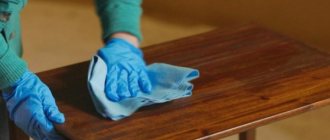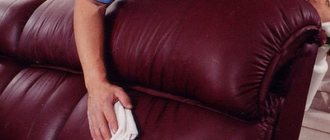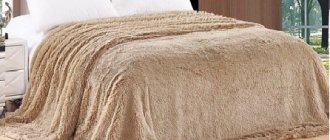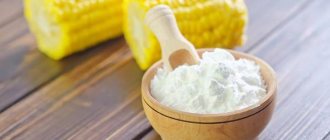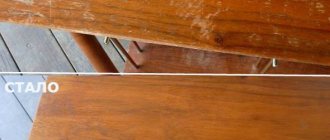Wooden furniture is the most suitable solution for modern apartments and houses.
Firstly, it fits perfectly with any design solution and easily fits into any apartment, thanks to a large selection of configurations. Secondly, such furniture is always in fashion and the demand for it is always great. But good, high-quality furniture requires daily care; this will allow you not only to extend its service life, but also to maintain the original condition of the furniture.
Preserving wooden furniture
Wooden furniture can be exposed to various aggressive environments. These include changes in temperature and humidity. Natural wood is a porous material, and therefore it can absorb and release moisture. Due to sudden changes in humidity, some furniture parts may swell or, on the contrary, dry out. This is noticeable by cabinet doors that don’t close or drawers that don’t open well. Wood insects are also sometimes observed in wooden furniture. All this may be a consequence of the fact that the temperature or humidity conditions of the room are disturbed.
liquid and moisture - aggressive effect on furniture
The ideal conditions for maintaining wooden furniture are: temperature from 20C to 250C, but humidity should be in the range of 45% -70%.
Any wooden furniture, along with changes in temperature and humidity, is afraid of sunlight. The fact is that when sunlight hits the surface of the furniture, its surface may burn out, and there is also a high probability of whitish spots or cracking of the varnish.
If regular cleaning isn't enough
It happens that stains of various origins, cracks, and scratches appear on wooden furniture. Standard cleaning will not help here: more serious measures are required.
- Traces from wet dishes are wiped with a walnut kernel. After the walnut layer has dried, the surface is rubbed with cloth.
- Traces from hot dishes are treated with paraffin and then ironed through the fabric with a warm iron. The final stage is polishing with a piece of cloth.
- Old stains are covered with a mixture of vegetable oil and table salt. After 2-3 hours, carefully remove the salt and wipe the surface with a woolen cloth.
- To remove areas of mold, use a cloth soaked in gasoline. A good effect in this case is achieved by treating surfaces with a product consisting of water (200 ml) and tea tree oil (5-6 drops).
- You can get rid of shallow scratches using wax or shoe polish that matches the color. If the furniture is made of dark wood (oak, walnut, mahogany), iodine is used for this purpose. Even ordinary strong tea leaves will help out here: it is applied with a cotton pad. The saturation of the brew is adjusted depending on the color of the surface being restored.
Wooden objects easily absorb foreign odors (for example, cigarette smoke), getting rid of which can be a problem. In such situations, a bowl of coffee grounds left inside a closet or chest of drawers will help. An alternative is to spray a mixture of white vinegar (0.5 cup) and water (2 cups) on the interior surfaces. If the foreign odor is very intense, the furniture is treated with a soda solution. You can simply sprinkle baking soda inside and remove it with a vacuum cleaner the next day.
Solid wood furniture
As a rule, solid wood furniture is not covered with varnish or stain; it can be treated with natural oils and waxes.
Thanks to this, almost any contamination or minor damage can always be corrected. If you regularly care for wooden furniture, even after 40 or 50 years it will look like new. Practical care tips:
- Furniture should only be wiped with a damp cloth;
- If you need to remove scratches, a special solution must be applied before cleaning the furniture. If the color of the solution casts doubt on the color of the furniture, then you should use a lighter shade. If the shade is darker, it will be too noticeable;
- To remove fingerprints or just grease stains, you will need matting wax. Typically it is used on oak, teak or pine surfaces;
- Used on unvarnished wood, nourishing milk should be poured onto the surface directly from the bottle and rubbed with a sponge;
- If you use wax, it must be applied with a dry, soft cloth. It is much more convenient to use aerosols.
How to wipe wood surfaces?
The surface of wooden furniture should be wiped with wax and vegetable oil using wet or dry wipes made of soft fabric or suede. In this case, movements must be made in the direction of the grain of the wood: this helps remove contaminants from the pores. It's better to do this every week.
And one more important tip: if water gets on the furniture, you need to wipe it off immediately so that moisture does not penetrate into the solid wood through the seams.
In addition, it is worth protecting furniture from impacts. To do this, place it so that the doors do not touch it when opening. You can use rubber suction cups that will serve as a shock absorber between the door and the furniture.
And every year it is recommended to check whether the fastenings are tightened well and, if necessary, tighten them. This will protect the structure from deformation and the wood in areas near the fastenings from destruction. It is also important to ensure that the furniture stands on a level floor, preventing its elements from becoming distorted. This will help keep your interiors looking great.
Proper care of solid wood furniture
When purchasing solid wood furniture, you should purchase special surface care products from the manufacturer; they are ideal for caring for wooden furniture and do not cause harm. One of the most popular products for such furniture is oil. It is applied in a small amount to the surface, left to absorb and wiped with a dry cloth. The amount and period of applying oil to the surface is purely individual, it all depends on the type of wood. Although it is worth remembering that by regularly applying oil to the surface, the process of cleaning it is much simpler and easier.
If you regularly use oils and waxes to care for wooden furniture, then liquid getting on the surface will not cause much harm; it will be enough to simply remove the liquid with a cloth. But if the liquid has been on the surface for a long time and has left its marks, to remove it you will need to wipe the mark with a hard surface of a sponge, and then treat it with oil.
Sometimes we miss various objects on furniture, what should we do if there is a dent? Provided that the wood fibers are not damaged, it is enough to iron the dent with a steam iron and then treat it with oil. If the dent or scratch is deep (up to 4 mm deep), you can use a hard sponge. But the most correct decision in this situation would be to contact specialists who will sand the required piece of surface, then coat it with oil.
Room layout
Wooden furniture should not be installed closer than 1 meter to heaters and heating systems, as this dries out the wood and leads to irreparable deformation.
Furniture should be arranged in such a way that it is not exposed to constant sunlight, as this will cause the furniture’s coating to fade. To protect wooden products, you can use translucent curtains or hang blinds.
Powerful light sources should also be avoided.
Equally important for the safety of wooden furniture is a flat surface underneath. Any irregularities entail distortion of the structure, which results in deformation of parts. This is especially true for large interior items such as cabinets, chests of drawers, shelving, etc. To maintain the balance of the furniture, you can place a suitable block.
Step-by-step instructions for caring for furniture
- Preparing furniture. Initially, you need to clean the wooden furniture from dust and dirt; to do this, you just need to wipe the surface with a damp soft cloth.
- Removing dents and scratches. It is worth treating the surface of the furniture with special products that repair minor scratches and dents.
- Treatment. In the case where the wood is varnished, all you need to do is use a polishing spray. If the wood is not varnished, then oil is used, which softens the fibers and gives them a natural, new look.
- Applying wax. The main task of wax is to protect the surface of furniture from dust and dirt. Wax also adds shine.
Removing existing contaminants
How to wipe wooden furniture when dirt appears? The answer to this question depends on what exactly caused the stains: mold, water, hot dishes, grease, and so on.
- Water stains on furniture are removed by rubbing with a walnut kernel. A film forms. When it dries, rub the area with a soft cloth.
- Drops of wax are removed with a knife preheated under running hot water. The remaining particles can be wiped off the surface of wooden furniture by soaking a napkin in gasoline.
- Mold can be easily removed using gasoline.
- To remove iodine stains from furniture, you need to rub it with a piece of raw potato.
- Grease stains are rubbed with talcum powder, the remnants of which are then wiped off with a dry cloth.
- To remove fingerprints from polished furniture, wipe the dirty area with a raw potato.
What should you not do?
Along with useful tips on caring for furniture, there is a list of things that are strictly forbidden to do with furniture, because it spoils and injures it. Let's look at what exactly it is not recommended to do:
- Wood is afraid of moisture, and therefore you should not store furniture (even for a short time) in places with high humidity;
- It is not recommended to place hot objects on the surface of furniture; you should use trays, tablecloths, stands;
- Do not allow aggressive media to come into contact with the surface of the furniture, such media include: nail polish, alcohol, solvent, gasoline;
- You should not use polish more than 3-4 times a year. A large amount of it forms a film on the surface of the furniture that cannot be removed;
- When removing dust, do not move objects standing on the surface. They need to be raised. This will help protect the furniture from scratches;
- When moving furniture, you should lift it, not pull it;
- You cannot lift furniture by its fragile parts (the table cannot be lifted by the tabletop, but by the legs, etc.)
By using all these tips, you will keep your furniture in perfect condition, and it will delight you for many years.
LiveInternetLiveInternet
How to care for furniture so that it lasts for many years?
Furnishings are not that cheap, and therefore many people want to extend their life. By properly treating cabinets, tables, sofas and armchairs with high-quality products, you can achieve their ideal condition for decades.
Sweep the floor first and then wipe off the dust. Brushes raise dust, so wait until it settles again before dusting off your furniture.
Wipe dust off the TV with an antistatic soft cloth. This type of cleaning will keep your TV clean for a long time. If anyone in your family has allergies, don't buy scented wipes.
How to clean upholstered furniture? Perhaps we should start with the fact that it is necessary to clean sofas, armchairs, chairs and beds, upholstered with soft filling and covered with fabric, using a regular vacuum cleaner. This way, the dust that accumulates there is removed.
♦ We clean upholstered furniture. Clean the upholstery of upholstered furniture with a vacuum cleaner or brush. The brush can be wrapped in gauze moistened with salt water (1 teaspoon of salt per 1 liter of water). Cleaning should only be done in one direction. Remove dust from armchairs, chairs, and sofas by covering them with a rag soaked in a solution of alcohol vinegar in water (1–2 tablespoons of vinegar per 1 liter of water). ♦ It is also recommended to use a steam cleaner at least once a month to destroy pathogenic, harmful bacteria, mites, and bedbugs in soft furnishings. The device heats a small amount of water to a boil, and then the upholstery is treated with this steam. In this way, you can clean your furnishings from dust and grease stains, and also eliminate unpleasant odors.
♦ You can use an upholstery cleaner , such as DryCleaner. This is a liquid that needs to be sprayed over the surface of sofas and armchairs, and then wiped with clean rags that do not leave lint on the surface being treated. This product removes not only ordinary dirt, but also greasy stains. It does not contain water or chlorine solvents, and therefore can be used to care for any upholstered furniture.
♦ We clean upholstery of upholstered furniture. The upholstery of upholstered furniture can be wiped with a clean woolen rag soaked in a warm solution of any synthetic detergent for woolen fabrics.
♦ If the furniture upholstery is shiny. Greasy areas can be cleaned with damp, clean sawdust (deciduous trees only) or heated bran.
♦ We clean decorative fabrics. Contaminated areas on decorative fabrics used to upholster furniture can be cleaned with washing powder dissolved in warm water. Grease stains are removed with a mixture of gasoline and washing powder, which is rubbed into the fabric and left overnight. In the morning, wash off the composition with hot water. Old stains are removed with a mixture of 10 g of gasoline and 1–2 g of colorless soap (“Children’s”). Rub it onto the stain and then wash it off with clean aviation gasoline.
♦ Cleaning velvet furniture. Furniture upholstered in velvet or plush is cleaned with a sponge dipped in warm water and wrung out thoroughly. It is not recommended to clean such coatings with a brush. It is better to wipe fleecy fabrics with a dry cloth. Grease stains are removed with clean aviation gasoline. Velvet or plush furniture should never be cleaned with a stiff-bristled brush.
♦ Cleaning upholstered furniture should be done in this order: first vacuum, then cover the entire soft covering with a damp cloth (add a spoonful of vinegar to the water) and beat it out through the cloth. All the dust will remain on the rag and not scatter throughout the apartment. Rinse the rag several times and continue beating the furniture until the rag is clean.
♦ How to remove stains from furniture upholstery. Cleaning upholstered furniture at home is most effective if it is carried out in a timely manner. A fresh stain can be removed quite easily, while an ingrained stain requires considerable effort to remove. When cleaning furniture with old stains, use one trick: hot steam treatment “revitalizes” the stains and helps to effectively remove them.
If stains appear on the upholstery, try cleaning them as follows:
- spilled wine should be cleaned up with cold water: cotton swabs are moistened with it and applied to the contaminated areas;
- onto the red wine , and then treat it with a rag soaked in a weak alcohol solution or vodka;
- Wine stains can also be neutralized by soda slaked with vinegar;
- beer spills on a sofa or chair, you should immediately blot it with a towel, and then treat it with soapy water and dry thoroughly;
- compote or berry juice is removed with a rag moistened with boiling water;
- traces of jam can be removed with a solution of laundry soap and vinegar (3 teaspoons of vinegar per 1 liter of warm soapy water)
- the stain of despair and coffee will disappear under the influence of laundry soap;
- stains from vegetables, fruits and juices are removed with a solution of citric acid, at the rate of 2 g of acid per glass of water;
- Fresh blood is removed from the surface of upholstered furniture as follows: wipe the stain with a rag soaked in cold water, and then treat it with laundry soap;
- chocolate stains are easily washed off with a concentrated saline solution;
- an old blood stain can be removed with aspirin dissolved in water (1 tablet per glass of water);
- To remove grease from upholstered furniture , sprinkle coarse salt onto the stain and then blot with a napkin.
- grease stains also wiped off with gasoline;
- paint stains with acetone or turpentine, and then wipe the area to be cleaned with ammonia (be careful with solvents: they can ruin some fabric coverings of furniture);
- ordinary liquid hand soap perfectly cleans any fabric surface from contamination.
♦ Use masking tape to collect cat hair on your couch. You can remove cat hair from your sofa using window tape, which is used when painting windows. Unwind the tape so that its sticky part is on the outside, and wrap it around a roller. Then roll it over the sofa or slipcovers in the car and the wool will stick to the tape. When the tape becomes clogged, tear off the used part and prepare a clean piece.
♦ We wash stuffing made from natural wool, feathers and down. Hot water with washing powder or other detergent dissolved in it is poured into a large container. Add 3 tbsp to water. spoons of ammonia. After the water has cooled slightly, the natural filler is lowered into the container, left for 2-3 hours, then wrung out, placed in a pillowcase and rinsed in clean warm water.
♦ We dry natural fillers. To dry, the washed, rinsed and wrung out filler is spread on a sheet, covered with gauze and dried first at room temperature, stirring occasionally, then in a warmer room.
♦ We clean velor covers. Covers made from velvet, corduroy and velor fabrics must be cleaned of dust with a brush and wiped with a soft woolen rag soaked in gasoline. The pillowcase is then dried and cleaned with a cloth dampened with denatured alcohol.
♦ If the velvet becomes wrinkled during the cleaning process. Lightly moisten the velvet with alcohol, hold over the steam for 3-4 minutes and wipe against the lint with a stiff, wide-toothed brush. The procedure should be repeated until the crumpled pile takes on its original appearance.
♦ Remove greasy stains from covers. If there are greasy stains from food products on the cover, they should be removed with warm water with the addition of ammonia or denatured alcohol at the rate of 1 tbsp. spoon for 1 glass of water.
How to care for leather furniture?
Not everyone thinks about how to clean furniture when they purchase rather expensive furniture covered with genuine leather. Such sofas, armchairs and chairs look very stylish and last a long time. However, they are very cool, so they are uncomfortable to wear during the cold season. Well, the most important thing is that greasy stains on such furniture are almost impossible to remove. In furniture cleaning companies, leather furniture is cleaned, degreased and repainted.
♦ Oily stains. Experienced housewives who don't want to pay big money to restore the usefulness of their leather sofas use baking soda and ammonia to remove grease stains. A teaspoon of soda should be diluted in a glass of water, and then rub the greasy stain on the skin with this solution and immediately wipe the treated area with a clean cloth. A teaspoon of ammonia is mixed with the same amount of water and soap shavings. The solution is applied to the greasy stain, and after exposure, the residue is removed with a clean rag. It should be remembered that ammonia can leave light stains.
♦ Buggy Super Leather, a now popular , helps to cope with most stains that remain on expensive upholstery. But if you do not have the opportunity to purchase one, then you should use regular liquid hand soap to wash leather sofas and armchairs.
♦ Old stains on leather sofas can be removed with a formalin-based solution . To prepare it, mix half a glass of formaldehyde, one teaspoon of soap shavings and the same amount of ammonia. The solution is applied to the stain and left for a couple of hours. Then wipe it off with a clean cloth.
♦ Cleaning leather upholstery. Upholstery made of natural or artificial leather is wiped with a damp cloth and refreshed with beaten egg white. It is applied with a clean woolen rag and rubbed.
♦ Another age-old cleaner that restores the shine and elasticity of dark leather upholstery is damp coffee grounds. Stains from leather upholstery are removed with a paste of potato starch and gasoline (1:1). It is rubbed into the contaminated area and cleaned off after drying.
♦ If you have leather furniture in your home, some tips will come in handy:
- The first thing you should strictly monitor is the behavior of your pets. Under no circumstances should they jump on leather furniture, much less sharpen their claws on leather sofas and armchairs. By the way, you yourself try not to come into contact with the surface of the furniture with your own skin. That is, you should not lie on a leather sofa with bare legs.
- Try not to allow furniture to come into contact with leather clothing. The paint of both materials can merge into one stain, which will be very difficult to remove. The same applies to clothing in bright colors. If you are unsure about the durability of the dyes on your clothes, it is better not to sit on furniture made of light leather tones in them.
- From time to time, try to simply vacuum leather furniture. This way you will remove dust from the skin pores. Dust can also be removed using a damp soft cloth without the use of special chemicals.
- Be careful if you sit on leather furniture with food in your hands. Many products leave stubborn stains on the skin that can only be removed later with the help of special products.
Faux leather furniture
Modern furniture upholstery materials made of artificial leather are distinguished by high performance and consumer qualities. In appearance, high-quality artificial leather, made on the basis of microfibers, sometimes does not differ at all from natural leather, and at the same time, furniture with artificial leather upholstery is much more affordable. The concept of “artificial leather” includes a large number of materials, many of which are not even used in furniture upholstery. And there are several types of materials that are similar in appearance to natural leather and are widely used for upholstery of upholstered furniture. These are the following materials:
- Vinyl leather.
- Dermantin.
- Eco leather (PU leather).
Caring for furniture with artificial leather upholstery does not differ depending on its type. There are several simple rules that will help you maintain the original appearance of products made from any type of leatherette:
- Do not use brushes even with soft bristles when cleaning
- Cleaning should be done with a piece of soft cloth .
- Do not place furniture in direct sunlight or near heating appliances.
- Avoid cleaning products that contain acids .
- Use a mild soap solution to remove recent stains.
- Use a 20% alcohol solution to remove old stains , then remove any remaining moisture with a cloth soaked in water, and then wipe the upholstery dry.
- Use special stain removers to remove stubborn stains.
- Do not use powders containing abrasive particles to avoid damaging the top layer.
- Do not clean with products containing chlorine .
♦ In order to increase the service life of eco-leather and improve the cleanability of the product, it is recommended to periodically treat it with water-repellent impregnations for natural leather. Excellent results are obtained by using professional cosmetics for the care of natural skin. Note that treatment with special impregnations is more relevant for light colors: snow-white, ivory, beige tones. Professional care products can be purchased in stores selling shoes, leather and leather goods.
♦ As you can see, leatherette furniture is much easier to care for. Caring for furniture upholstery made of artificial leather and removing household dirt comes down to wiping its polymer surface with a soft cloth or sponge soaked in a weak solution of soap or detergent for washing items made of wool, silk and synthetic fabrics (solution temperature up to 35 degrees), avoiding getting the underside of the skin wet. Residues of detergent are removed with a slightly damp cloth, excess moisture with a soft cotton cloth, being sure to wipe dry.
♦ In the same way, dust deposits and dirt are removed. If it is not possible to get rid of the contamination immediately, it is allowed to use a 40-50% alcohol-water solution or ammonia. Various old stains of organic origin are removed with cleaners for natural leather, according to the instructions for their use.
♦ To remove stains and dirt , for example from coffee, wine, grease, you must immediately wipe the surface with a soft sponge or cloth soaked in a weak solution of detergent (soap or shampoo).
♦ It should also be remembered that it is impossible to remove cuts, scratches, cracks, marks from hot objects from the surface of artificial leather upholstery. That is why upholstered furniture upholstered in artificial leather should be handled very carefully. And then such furniture will serve you for many years without losing its original appearance and performance characteristics.
How to care for natural wood furniture
Wood is very sensitive to moisture. Wipe wooden furniture only with a dry, soft flannel or cloth cloth.
♦ Furniture made from valuable wood requires especially careful care. It must be protected from hot or too cold objects that may leave marks on the surface. Therefore, it is recommended to use special coasters for dishes, tablecloths and other accessories.
♦ Wipe the veneer surface regularly with a slightly damp cotton cloth. In addition, special gentle detergents can be used to care for veneered and solid wood furniture; they will preserve its appearance and make the furniture resistant to dust.
♦ For the care of wooden furniture, the industry offers products in the form of liquids, aerosols, pastes and special wipes. You should also know that wood does not tolerate high humidity and is afraid of solvents.
Cleaning preparations for wood surfaces are represented by two main groups - oil-based and wax-based:
- the former are suitable for cleaning and protecting any wooden surfaces. Oil cleaning compositions gently care for wood, efficiently remove dirt, give shine and fresh color;
- Wax-based preparations are intended for polished surfaces. Using wax products you can prevent the formation of dirt, scuffs and small scratches. They do not leave streaks, have dust-repellent properties and have an antistatic effect, which together helps keep polished furniture in perfect condition.
Any store offers cleaning and protective products for wooden furniture:
— Centralin;
— Diava;
- Mebelux;
— Fairytale furniture, etc.
But if you do not want to use chemicals, then use the advice of experienced housewives.
♦ The best way to remove dust on wooden furniture with an uneven surface is a special furniture brush.
♦ It would be useful to remind you that wooden furnishings cannot be washed with a large amount of water using a sponge . It is better to use a soft cloth soaked in water and, after treating the surface, immediately wipe the latter with a dry cloth. After the wooden tables, cabinets and chairs are dry, they are treated with special polishes.
♦ We clean wooden furniture. Mix 1 tbsp. spoon (15 ml) of quality olive oil and 2 tbsp. tablespoons (30 ml) lemon juice or vinegar. Spray the mixture from a plastic spray bottle or dampen a clean, soft cloth with it and wipe the wood furniture. Vinegar removes dirt from wooden surfaces, and oil prevents them from drying out.
♦ We polish wooden furniture. Lemon oil is an excellent product for polishing wood furniture because it restores shine and acts as an antiseptic. Most finished products contain synthetic components, including petroleum distillate. In order to prepare a natural shine for furniture with a pleasant smell, combine 10 drops of natural lemon oil and 2 tbsp. spoons (30 ml) of lemon juice, then pour in 5 drops of quality olive oil or jojoba oil. Lightly dampen a clean flannel cloth with this mixture and rub the furniture until it shines.
♦ We clean light unpolished wood furniture. In a clean bowl, heat white stearin with gasoline (1:1) to form a thick mixture. Then cool it and use a soft cloth to rub the entire surface of the furniture. After two hours, polish it with a clean flannel cloth.
♦ We care for oak furniture. Oak furniture, especially greasy stains on it, should be cleaned with warm beer. To give it shine, wipe it with a cotton swab soaked in a boiled and then slightly cooled mixture of beer (1 glass), sugar (1 tablespoon) and wax (20 g). For these purposes, you can buy wax in hardware stores or crumble wax candles. The mixture is boiled in a water bath. The mixture is still hot, but not too hot, evenly applied to the fabric, lightly squeezed and greasy stains are carefully wiped off with vertical movements. There is no need to rub the greasy stain. After the surface has dried, the furniture is polished with a woolen cloth.
♦ We care for mahogany furniture. It is recommended to wipe mahogany furniture with a cloth moistened with vegetable oil.
♦ If you have expensive walnut cabinets and tables, you can tidy them up with olive oil and red wine.
♦ We clean unpolished furniture. Unpolished furniture should be cleaned with a vacuum cleaner with a soft attachment or wiped off dust with a soft, dry cloth. You can periodically wipe it with a damp swab, and if it is very dirty, wash it with warm water and soap and wipe dry.
♦ White furniture should be cared for using low-fat cream or milk. After treating the furniture surface with it, you should wipe it with a woolen rag.
♦ We remove scratches from oak furniture. Scratches that appear on oak or walnut furniture can be masked by rubbing a weak iodine solution into them with a cotton swab.
♦ We remove scratches from furniture. You can rub a little shoe polish of a suitable color into a shallow scratch on a polished surface and polish it with a cloth.
♦ Try filling in the scratch with a felt-tipped marker. You can find these markers in a variety of wood tones at hardware stores. Apply the marker directly to the scratch. If you get a felt-tip pen on an undamaged surface, wipe it off immediately.
♦ You can also wax-based colored chalk that matches the color Also, at a furniture or hardware store, buy furniture wax to match your furniture. Wax can be soft or hard, in the form of pencils or bars.
♦ Another way to remove scratches. Scratches on furniture can be repaired with a special mastic. To prepare it, dissolve 4 parts wax in 3 parts turpentine over low heat, then stir, pour 2 parts alcohol into the mixture and stir again. Before wiping away scratches, wipe them with a piece of woolen cloth soaked in clean aviation gasoline. Then apply mastic with a cotton swab and rub until shiny with a soft woolen cloth. The mastic should be stored in a glass jar with a ground stopper.
♦ We remove water stains from furniture. A water stain can be sprinkled with flour and wiped off with a swab dipped in vegetable oil.
♦ After any treatment of wooden furniture, always wipe the surface dry with a soft cloth. To maintain the natural shine of a wooden surface, you can periodically rub it with linseed oil, and if you don’t have linseed oil, then use olive oil.
How to care for polished furniture
Care of lacquered furniture. Polished and varnished furniture is quite capricious - it is damaged by dampness and excessive dryness, dust, heat from radiators and sunlight. These unfavorable factors may cause cloudy spots and cracks to appear on a beautiful surface; it may fade and warp.
♦ On the shiny surface of such furniture, both dust and finger stains are immediately visible, so you need to take care of it often. Regular care involves wiping with a dry flannel or felt cloth. You can purchase special napkins with lint and special impregnation that perfectly remove dust and prevent its accumulation.
♦ Do not wipe polished surfaces with wet rags. This leaves stains on the smooth surface, the veneer may peel off, and the surface may darken.
♦ More thorough cleaning can be done using polish - you need to moisten a soft cloth with it and wipe the surface, and after 20 minutes polish it until it shines.
♦ In case of heavy contamination, the polished surface will have to be washed carefully. You should not use soap solutions to wash it, as this may ruin the varnish. The best cleaning agent is considered to be water with a small amount of ammonia (to 6 parts water, take 1 part alcohol). It is not recommended to wipe furniture with water only.
♦ We clean polished furniture. Boil a glass of beer with a piece of wax. Then cool the composition and apply it warm to the surface of the furniture. When dry, rub with a woolen rag.
♦ Another way to care for polished furniture . You can also wipe the furniture with a swab moistened with vegetable (preferably burdock) oil. Polished furniture can be easily cleaned with tea leaves wrapped in a piece of soft cloth. After cleaning, the furniture is wiped with a soft woolen cloth.
♦ Fingerprints can be removed by rubbing them with talcum powder or raw potatoes.
♦ Traces of splashes can be removed with a solution of vinegar with the addition of a few drops of vegetable oil.
♦ If there are old stains , you can get rid of them using cabbage brine.
♦ To improve the appearance of wooden furniture, you can make a homemade polish. To do this, mix flax oil, vinegar and turpentine in equal parts. Apply the resulting composition onto a napkin and rub the furniture.
♦ Down with the scratches. You'll need a set of children's crayons if you find scratches on your polished furniture. Take a moment to match the color, then apply strokes across the scratch, wiping off the excess with cardboard or plastic card. Then rub in some furniture polish or a drop of lemon oil. If you want to match the color as accurately as possible, then buy furniture grout, which is sold in almost all hardware departments.
♦ Removing iodine stains. Iodine stains can be removed from lacquered furniture by rubbing them with half a cut potato.
♦ Water stains on lacquered furniture. If water gets on the varnished surface of the furniture and a trace remains, then this area should be lightly sprinkled with flour and wiped with a cloth soaked in machine or Provençal oil.
♦ We remove marks from glasses on the polished surface. Often wet glasses leave marks on the polished surface of the table. You can get rid of them by rubbing these places with a walnut kernel. When the oil released from the nut dries, the surface must be rubbed with a cloth, after which the table will be clean and shiny again.
♦ Removing stains from hot dishes. Do not place hot objects on the surface of the furniture without a thermal insulation pad.
♦ Whitish stains left on a polished surface from hot dishes are difficult to remove. There are different types of varnish coatings, and not all products work equally on them. You can try smearing the stain with Vaseline overnight, and in the morning wipe the area and polish it. An old stain can be smeared with a mixture of table salt and vegetable oil, and after 2-3 hours, wipe the area with a woolen rag. Or moisten a woolen rag with alcohol and vegetable oil, and then polish the surface with this mixture. You can also rub the stain with a piece of paraffin and iron it with a not too hot iron. After some time, polish this place with a cloth.
♦ Removing wax stains. Sometimes frozen drops of candle wax remain on polished furniture. In this case, you need to heat the knife in boiling water, remove the wax with it, and wash off the remaining mark with warm water or wipe it with a rag soaked in gasoline. If the stain still remains, it should be polished with furniture polish.
♦ The most effective means of caring for polished furnishings:
- Penol;
— Furniture nitrovarnish;
— Spindums;
— Sparkle;
— Furniture freshener;
- Gloss.
♦ Surfaces of products with paint coatings should be protected from liquids, especially those that dissolve paint films (alcohol, acetone, gasoline ). Any liquid that accidentally gets on the surface should be immediately removed with a dry cloth.
Caring for furniture made of chipboard and MDF
Furniture made from chipboards is of high quality, does not deteriorate over the years and does not lose its attractiveness. Additional advantages of such furniture are environmental friendliness, durability, beautiful appearance and affordable prices.
♦ MDF is one of the wood derivatives; this material is distinguished by its fairly high density and moisture resistance. Usually, a special coating is applied to the front surface of MDF, which makes it quite easy to clean. Furniture made from this material can be wiped with a damp cloth and treated with cleaning agents without any special contraindications (the main thing is that they do not contain chlorine). The only exception is MDF with a glossy surface; it is strictly not recommended to treat it with powders and brushes, and only a soap-based product and polish are suitable for cleaning it.
♦ Laminated chipboard is currently the most widely used in the production of cabinet furniture. The particle board is covered with films made from decorative papers, which are impregnated with high-quality melamine resins.
♦ It is enough to wipe furniture with a plastic coating once a week with a damp cloth; stains can be removed from it in the same way. It is not advisable to place such pieces of furniture in direct sunlight or near heating devices, otherwise it may crack and quickly fail.
♦ Furniture without covering. When using any chemical product to care for furniture, you must carefully read its instructions and determine for which materials it is suitable. It is strictly forbidden to use hard objects when cleaning furniture - be it a scraper or a lint sponge. It is recommended to use a soft cloth.
♦ Avoid high humidity in the room - these materials are afraid of dampness. That is why it is recommended to wipe the sides of the cabinet with a dry cloth or brush. If a stain appears, use a mild soap solution and then wipe the area dry.
♦ In case of heavy soiling, you can use a mild furniture cleaner and wipe dry with an absorbent cloth.
♦ Also, stains are removed from it using a solution consisting of water, ethyl alcohol and liquid soap. Immediately after wiping off the stains, wipe the affected areas with a dry cloth.
♦ When washing the floor, you should try not to catch the base.
Plastic furniture
Aerosols are used as a cleaning product for plastic furniture, which are applied according to standard rules: spray the product on the surface and wipe dry. Aerosols are also good at removing greasy stains.
♦ Plastic tolerates water well , so it can be easily cleaned with a regular soap solution or using dishwashing gel. After cleaning, rinse off the solution thoroughly and wipe with a dry cloth so that no streaks remain.
♦ A solution of water, soda and vinegar (10:1:1) works well for greasy stains on plastic surfaces.
♦ Tartar (tartar) removes stubborn stains. If there are stubborn stains on your plastic furniture or toys, purchase the kind of tartare used by bakers. Mix 1 tbsp. spoon (9 g) of tartare with 1 tbsp. spoon (15 ml) of lemon juice or white vinegar and apply the resulting paste to the stain using a cotton swab. Leave the paste on for half an hour and then wash it off. The stain will become much lighter or disappear completely.
Care of glass surfaces
Glass surfaces are quite capricious - dust quickly settles and lingers on them, and any touch leads to the formation of stains. Therefore, glass interior elements require regular cleaning.
♦ During meals, it is advisable to cover tabletops (including those made of heat-resistant glass) with a tablecloth or place dishes with food and drinks on table mats.
♦ If there are stains from dried food or circles from dishes on the surface, they should not be removed with metallic sponges or cleaned with powders containing abrasive particles: this will make the glass cloudy, and it will be difficult to restore its shine. Wipe the stains with a cloth soaked in a cleaning solution, let the stain soak, then wash the countertop with warm soapy water, rinse with clean water and wipe dry with a soft cloth.
♦ If your home has cabinets with glass or mirror fronts, remember that glass is a very fragile material. For cleaning, it is recommended to use special glass cleaners - this will help avoid streaks.
♦ If mirrors are built into the closet, they can be wiped with ammonia. Using synthetic products can cause clouding of the surface;
♦ Fix glass defects in a bookcase. It happens that the glass in a bookcase or sideboard is difficult to move in the groove. In this case, you need to lubricate the bottom edge of the glass with Vaseline. And if the glass of the bookcase constantly rattles, you need to place a sponge rubber ball or a piece of rubber tube between them. The diameter of such a gasket should slightly exceed the gap between the glasses.
Helpful Tips:
♦ We clean darkened metal furniture parts/fittings. Tarnished and darkened metal parts of furniture can be cleaned with a mixture of ammonia (30 g), chalk or tooth powder (15 g) and water (50 g). Moisten a flannel rag with this mixture and wipe the parts. After this, they are polished to a shine with cloth. You can use soda, a cut onion, lemon juice for cleaning, and then polish the parts with chalk moistened with ammonia and water (2:1).
♦ If the room is damp. In damp rooms, the back walls of furniture should be covered with wax paper. It protects furniture well from dampness.
♦ Removing mold stains. Mold stains that appear on furniture in a damp room are removed with gasoline.
♦ Constantly ventilate the room in which the wardrobe is located. This will avoid increased levels of humidity, which negatively affects the furniture;
♦ Do not overload the cabinet beyond normal limits. The glass shelves are designed for 12 kilograms, the end hanger is for the same weight. Remember not to put too many things in closets or racks. Do not exceed the maximum permissible static load: it is not recommended to place more than 20 kg on standard shelves of cabinets and racks; as for drawers, the limit here is 10 kg. Keep in mind that moderate load increases the period of use of furniture.
♦ If the hinges on the cabinets begin to creak , they can be lubricated with paraffin or adjusted.
♦ Prevent bugs from appearing in furniture. To prevent the appearance of grinder beetles, do not clutter your apartment with old unnecessary wooden objects and ventilate the room as often as possible. It is best to remove furniture affected by the borer beetle from the apartment. To prevent the appearance of the grinder beetle, it is recommended to wipe the unvarnished or painted parts of the furniture once or twice a year with a cloth soaked in a solution of sodium fluoride or sodium fluoride (200–250 g per bucket of hot water). The solution is thoroughly stirred and used after cooling. You can also treat furniture with a composition of turpentine (100 parts), wax (5 parts), paraffin (5 parts) and creolin (3 parts).
♦ Preventive treatment of furniture against grinder beetles can be carried out at any time of the year, but the best period for this is from July to January. Furniture affected by the beetle is usually treated 2-3 times a month.
♦ Keep your piano clean. If there is a piano in the house, it should be placed away from heating devices and windows. This instrument is damaged by sudden changes in temperature, dust, excessive dryness or humidity. When caring for a piano, you need to regularly wipe it from dust, remove it not only from the surface of the instrument, but also from the inside, periodically opening its bottom cover. The piano must be protected from moths, which can damage the hammers covered with felt. Gauze bags with anti-moth agent should be hung from the instrument deck.
Proper care of furniture is not as difficult as it might seem at first glance. If you take into account all the rules and regularly wipe or vacuum the furniture, you will be able to prolong its use for a long time. Based on materials from www.e-reading.club
To the hostesses:
A product that will remove scratches from any wooden furniture
How to remove greasy deposits on wooden kitchen cabinets?
How to restore worn corners on furniture?
Useful tips
Cleaning polished furniture at home is not so difficult, but you should follow some rules to avoid possible problems:
- Before using one of the cleaning compounds on furniture, put on rubber gloves. If the product has a pungent odor, also wear a respirator or a cotton-gauze bandage. You will protect yourself from contact of aggressive agents and their vapors with your skin and respiratory tract.
- Before you begin surface treatment, test the product you choose. It is necessary to apply a small amount to an inconspicuous area and wait a while. If no unexpected reaction occurs, you can safely use the product.
- If the composition you are using does not work and you want to try another, thoroughly rinse off the previous product. Otherwise, the components may enter into a chemical reaction, which may leave streaks, stains and other unforeseen consequences.
- If the recipe calls for the product to dry, let it dry naturally. Do not use a hair dryer or other heating devices;
- When cleaning, do not use large amounts of water.
If you properly and regularly care for polished furniture, it will serve you for many years, delighting you and your loved ones.
Important nuances of working with plywood
Plywood is a convenient material for carpentry, but certain rules must be followed. In particular, a special approach is needed when cutting sheets. To avoid defects, make an even cut with a jigsaw or circular saw, apply a ruler to the drawn line and follow the mark with a stationery knife. Another option is to place sticky tape on both sides of the pencil line.
Article on the topic: How to arrange furniture in a kitchen of 12 sq.m.
The cutting technique is affected by the thickness of the plywood. When cutting, you must hold the saw so that the blade protrudes 5 mm beyond the sheet. That is, with a plate thickness of 15 mm, the immersion depth of the cutting tool is 20 mm. In this case, the sheet should lie face down on the support. The direction of the cut depends on the device used. A jigsaw allows you to cut material straight and curved. Use a circular saw to cut in a straight direction.
Plywood parts cannot be joined without first creating holes for fastenings.
Independent production of curved glued forms also requires compliance with some nuances. The rounded product is tightened with rigging straps for 3–4 days until the shape is fixed. Pre-steaming the plywood sheets makes bending easier.
Due to the large number of advantages, this type of raw material is included in the group of popular modern materials. Making your own pieces of furniture from plywood is not difficult if the class and thickness of the slabs are selected correctly, the drawing is correctly executed, and all technological stages of assembly are followed. Finished interior items are practically not inferior in appearance and performance to their analogues made from natural wood.
How to restore veneer
Veneered furniture requires a special approach. The means are basically the same, the methods are different. For example, if after getting hit the veneer is swollen, fill a disposable syringe with PVA glue, pierce the bubble, and inject glue into the cavity. Place a piece of thick fabric on top and place a weight. If the surface is uneven (convex or concave), use a thick fabric bag with heated sand as a load.
Such veneer damage is restored in two stages. First, the swelling is eliminated, then the scratch is painted over and the coating is restored.
If the veneer is glued with alcohol glue, you can return the swollen part to its place by ironing it through a rag with a hot iron. But do not overheat the iron: the veneer may stretch. Heating level is medium.
If ironing with a dry cloth does not help, try repeating the operation with a damp cloth (wet it and wring it out well). There is a chance that the wood will swell and become more elastic. To reliably fix the swelling, you can introduce PVA there and then heat it with an iron.
If the swelling is cracked, you can also try to seal it with heating (through a rag). If it doesn’t work, tear off the peeled piece. You don’t cut it, but rather break it off: on veneer, breaks after restoration are less noticeable than cuts. Therefore, you break off the lagging piece. Remove the old glue from the damaged area and the piece of veneer (with sandpaper or a nail file, depending on the size). Next, the repair of veneer on furniture is standard: spread it with PVA glue, lay it down, aligning the fault lines, lay a thick fabric on top and place a weight until it dries.
Article on the topic: Where is the furniture Yandex market reviews
Such veneer peeling can most likely be eliminated simply by ironing it with an iron.
Scratches and traces of restoration on veneer are removed in the same way as on wood: they are painted over with a furniture marker of a suitable shade. If the scratch is deep, a little melted furniture restoration wax is applied to it (with a spatula). After drying, the wax is ground, and if necessary, fine-grain sandpaper is used, but after this treatment, the restored piece is covered with a layer of varnish.
Do-it-yourself furniture restoration requires patience and accuracy. You have to act gradually and methodically: smear it, wait for it to dry, level it, smear it again, etc. Sometimes you have to try several methods: damage varies, as do the materials used in production (glue, varnish, etc.). But as a result, the furniture will look much better.

